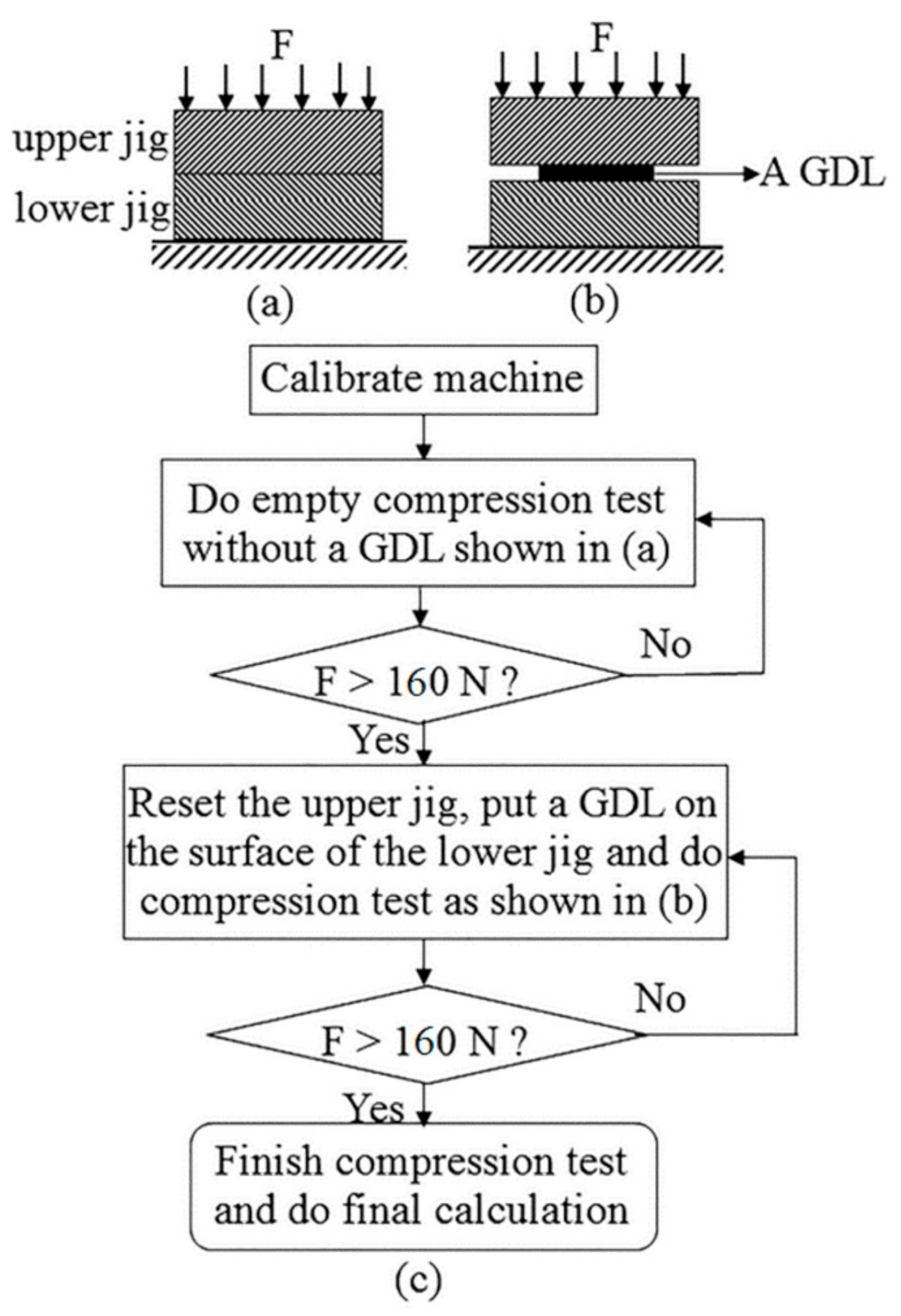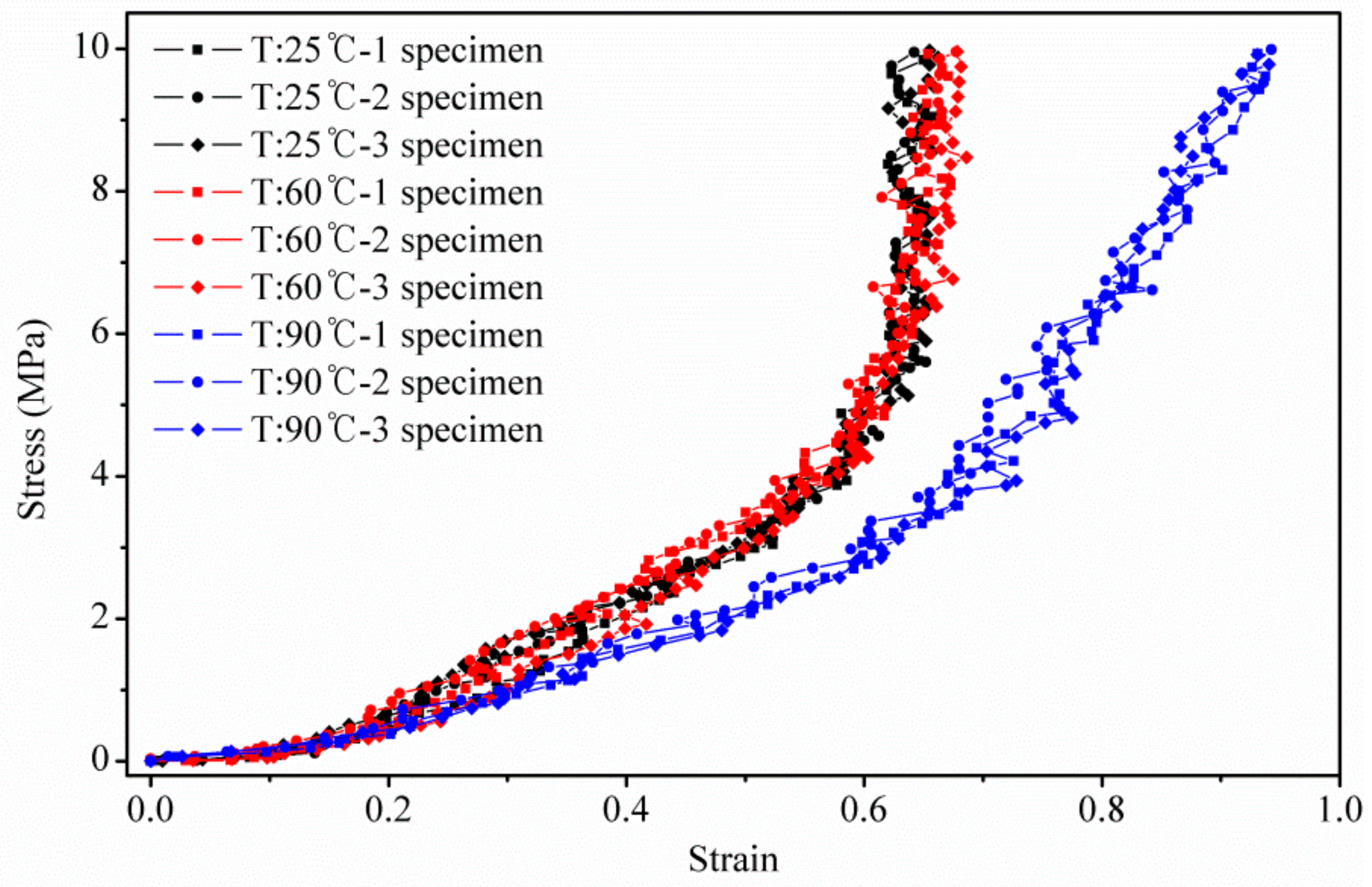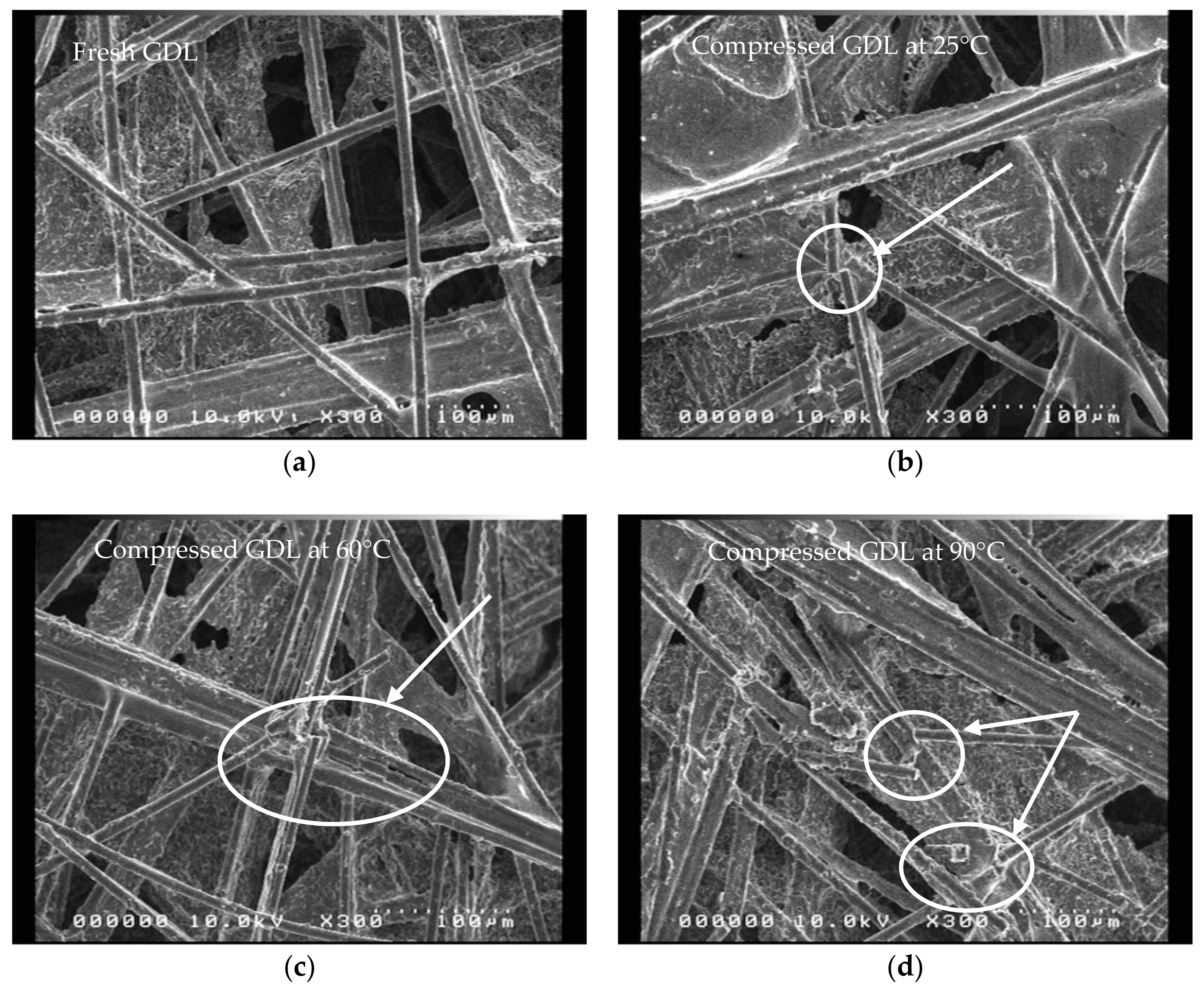An Investigation of the Compressive Behavior of Polymer Electrode Membrane Fuel Cell’s Gas Diffusion Layers under Different Temperatures
Abstract
:1. Introduction
2. Experimental Section
2.1. Experimental Setup
2.2. Experimental Procedures
2.3. Data Processing
3. Results and Discussion
3.1. Compression Test Results
3.2. GDLs’ Microstructure Observation
4. Conclusions
Author Contributions
Funding
Acknowledgments
Conflicts of Interest
References
- Poornesh, K.K.; Cho, C.; Kim, D.Y.; Tak, Y. Effect of gas-diffusion electrode material heterogeneity on the structural integrity of polymer electrolyte fuel cell. Energy 2010, 35, 5241–5249. [Google Scholar] [CrossRef]
- Mehta, V.; Cooper, J.S. Review and analysis of pem fuel cell design and manufacturing. J. Power Sources 2003, 114, 32–53. [Google Scholar] [CrossRef]
- Cindrella, L.; Kannan, A.M.; Lin, J.F.; Saminathan, K.; Ho, Y.; Lin, C.W.; Wertz, J. Gas diffusion layer for proton exchange membrane fuel cells—A review. J. Power Sources 2009, 194, 146–160. [Google Scholar] [CrossRef]
- Hung, C.H.; Chiu, C.H.; Wang, S.P.; Chiang, I.L.; Yang, H. Ultra thin gas diffusion layer development for PEMFC. Int. J. Hydrogen Energy 2012, 37, 12805–12812. [Google Scholar] [CrossRef]
- Kim, H.; Lee, Y.J.; Lee, S.J.; Chung, Y.S.; Yoo, Y. Fabrication of carbon papers using polyacrylonitrile fibers as a binder. J. Mater. Sci. 2014, 49, 3831–3838. [Google Scholar] [CrossRef]
- Williams, M.V.; Begg, E.; Bonville, L.; Kunz, H.R.; Fenton, J.M. Characterization of gas diffusion layers for PEMFC. J. Electrochem. Soc. 2004, 151, A1173–A1180. [Google Scholar] [CrossRef]
- Arisetty, S.; Prasad, A.K.; Advani, S.G. Metal foams as flow field and gas diffusion layer in direct methanol fuel cells. J. Power Sources 2007, 165, 49–57. [Google Scholar] [CrossRef]
- Liu, H.S.; Song, C.J.; Zhang, L.; Zhang, J.J.; Wang, H.J.; Wilkinson, D.P. A review of anode catalysis in the direct methanol fuel cell. J. Power Sources 2006, 155, 95–110. [Google Scholar] [CrossRef]
- Mathias, M.; Roth, J.; Fleming, J.; Lehnert, W. Diffusion media materials and characterization. In Handbook of Fuel Cells—Fundamentals, Technology and Applications; Wiley: Hoboken, NJ, USA, 2003; pp. 517–537. [Google Scholar]
- Ishikawa, H.; Henning, S.; Herranz, J.; Eychmuller, A.; Uchida, M.; Schmidt, T.J. Tomographic analysis and modeling of polymer electrolyte fuel cell unsupported catalyst layers. J. Electrochem. Soc. 2018, 165, F7–F16. [Google Scholar] [CrossRef]
- Faydi, Y.; Lachat, R.; Meyer, Y. Thermomechanical characterisation of commercial gas diffusion layers of a proton exchange membrane fuel cell for high compressive pre-loads under dynamic excitation. Fuel 2016, 182, 124–130. [Google Scholar] [CrossRef]
- Chippar, P.; Kyeongmin, O.; Kang, K.; Ju, H. A numerical investigation of the effects of gdl compression and intrusion in polymer electrolyte fuel cells (PEFCS). Int. J. Hydrogen Energy 2012, 37, 6326–6338. [Google Scholar] [CrossRef]
- Mason, T.J.; Millichamp, J.; Neville, T.P.; El-kharouf, A.; Pollet, B.G.; Brett, D.J.L. Effect of clamping pressure on ohmic resistance and compression of gas diffusion layers for polymer electrolyte fuel cells. J. Power Sources 2012, 219, 52–59. [Google Scholar] [CrossRef]
- Radhakrishnan, V.; Haridoss, P. Effect of cyclic compression on structure and properties of a gas diffusion layer used in pem fuel cells. Int. J. Hydrogen Energy 2010, 35, 11107–11118. [Google Scholar] [CrossRef]
- Zhou, P.; Wu, C.W. Numerical study on the compression effect of gas diffusion layer on PEMFC performance. J. Power Sources 2007, 170, 93–100. [Google Scholar] [CrossRef]
- Poornesh, K.K.; Cho, C.D.; Lee, G.B.; Tak, Y.S. Gradation of mechanical properties in gas-diffusion electrode. Part 2: Heterogeneous carbon fiber and damage evolution in cell layers. J. Power Sources 2010, 195, 2718–2730. [Google Scholar] [CrossRef]
- Radhakrishnan, V.; Haridoss, P. Effect of gdl compression on pressure drop and pressure distribution in PEMFC flow field. Int. J. Hydrogen Energy 2011, 36, 14823–14828. [Google Scholar] [CrossRef]
- Escribano, S.; Blachot, J.F.; Etheve, M.; Morin, A.; Mosdale, R. Characterization of PEMFCs gas diffusion layers properties. J. Power Sources 2006, 156, 8–13. [Google Scholar] [CrossRef]
- Norouzifard, V.; Bahrami, M. Deformation of PEM fuel cell gas diffusion layers under compressive loading: An analytical approach. J. Power Sources 2014, 264, 92–99. [Google Scholar] [CrossRef]
- Gigos, P.A.; Faydi, Y.; Meyer, Y. Mechanical characterization and analytical modeling of gas diffusion layers under cyclic compression. Int. J. Hydrogen Energy 2015, 40, 5958–5965. [Google Scholar] [CrossRef]
- Belkhiri, Z.; Zeroual, M.; Moussa, H.B.; Zitouni, B. Effect of temperature and water content on the performance of pem fuel cell. Revue des Energies Renouvelables 2011, 14, 121–130. [Google Scholar]
- Barbir, F.; Balasubramanian, B.; Neutzler, J. Optimal operating temperature and pressure of pem fuel cell systems in automotive applications. In Preprints of Symposia; Division of Fuel Chemistry: New Orleans, LA, USA, 1999. [Google Scholar]
- Liu, D.A.; Peng, L.F.; Lai, X.M. Effect of dimensional error of metallic bipolar plate on the gdl pressure distribution in the PEM fuel cell. Int. J. Hydrogen Energy 2009, 34, 990–997. [Google Scholar] [CrossRef]
- Qiu, D.K.; Yi, P.Y.; Peng, L.F.; Lai, X.M. Study on shape error effect of metallic bipolar plate on the GDL contact pressure distribution in proton exchange membrane fuel cell. Int. J. Hydrogen Energy 2013, 38, 6762–6772. [Google Scholar] [CrossRef]
- Bograchev, D.; Gueguen, M.; Grandidier, J.C.; Martemianov, S. Stress and plastic deformation of MEA in running fuel cell. Int. J. Hydrogen Energy 2008, 33, 5703–5717. [Google Scholar] [CrossRef]
- Kleemann, J.; Finsterwalder, F.; Tillmetz, W. Characterisation of mechanical behaviour and coupled electrical properties of polymer electrolyte membrane fuel cell gas diffusion layers. J. Power Sources 2009, 190, 92–102. [Google Scholar] [CrossRef]
- Corti, H.R.; Gonzalez, E.R. Direct Alcohol Fuel Cells: Materials, Performance, Durability and Applications; Springer Science & Business Media: Berlin, Germany, 2013. [Google Scholar]
- Kausar, A.; Rafique, I.; Muhammad, B. Review of applications of polymer/carbon nanotubes and epoxy/cnt composites. Polym. Plast. Technol. 2016, 55, 1167–1191. [Google Scholar] [CrossRef]
- Taherian, R.; Ghorbani, M.M.; Kiahosseini, S.R. A new method for optimal fabrication of carbon composite paper as gas diffusion layer used in proton exchange membrane of fuel cells. J. Electroanal. Chem. 2018, 815, 90–97. [Google Scholar] [CrossRef]
- Gutierrez, M.C.; De Paoli, M.A.; Felisberti, M.I. Cellulose acetate and short curaua fibers biocomposites prepared by large scale processing: Reinforcing and thermal insulating properties. Ind. Crops Prod. 2014, 52, 363–372. [Google Scholar] [CrossRef]
- Agarwal, G.; Patnaik, A.; Sharma, R. Mechanical and thermo–mechanical properties of bi-directional and short carbon fiber reinforced epoxy composites. J. Eng. Sci. Technol. 2014, 9, 590–604. [Google Scholar]
- Zhou, J.; Yao, Z.; Chen, Y.; Wei, D.; Wu, Y.; Xu, T. Mechanical and thermal properties of graphene oxide/phenolic resin composite. Polym. Compos. 2013, 34, 1245–1249. [Google Scholar] [CrossRef]
- Zhang, Z.; Klein, P.; Friedrich, K. Dynamic mechanical properties of ptfe based short carbon fibre reinforced composites: Experiment and artificial neural network prediction. Compos. Sci. Technol. 2002, 62, 1001–1009. [Google Scholar] [CrossRef]





| Property | Value |
|---|---|
| Area weight | 110 ± 5 g/m2 |
| Thickness | 320 ± 20 μm |
| Porosity | ˂90% |
| Electrical resistivity | <20 mΩ∙cm2 |
| Parameter | Value |
|---|---|
| Maximum temperature | 150 °C |
| Thermostat accuracy | ±2 °C |
| Maximum humidity | 90% |
| Humidity accuracy | ±5% |
| Load cell capacity | 200 N |
| Load cell sensitivity | ±0.02 N |
| Head moving speed | 0.001–100 mm/s |
© 2018 by the authors. Licensee MDPI, Basel, Switzerland. This article is an open access article distributed under the terms and conditions of the Creative Commons Attribution (CC BY) license (http://creativecommons.org/licenses/by/4.0/).
Share and Cite
Chen, Y.; Jiang, C.; Cho, C. An Investigation of the Compressive Behavior of Polymer Electrode Membrane Fuel Cell’s Gas Diffusion Layers under Different Temperatures. Polymers 2018, 10, 971. https://doi.org/10.3390/polym10090971
Chen Y, Jiang C, Cho C. An Investigation of the Compressive Behavior of Polymer Electrode Membrane Fuel Cell’s Gas Diffusion Layers under Different Temperatures. Polymers. 2018; 10(9):971. https://doi.org/10.3390/polym10090971
Chicago/Turabian StyleChen, Yanqin, Chao Jiang, and Chongdu Cho. 2018. "An Investigation of the Compressive Behavior of Polymer Electrode Membrane Fuel Cell’s Gas Diffusion Layers under Different Temperatures" Polymers 10, no. 9: 971. https://doi.org/10.3390/polym10090971





